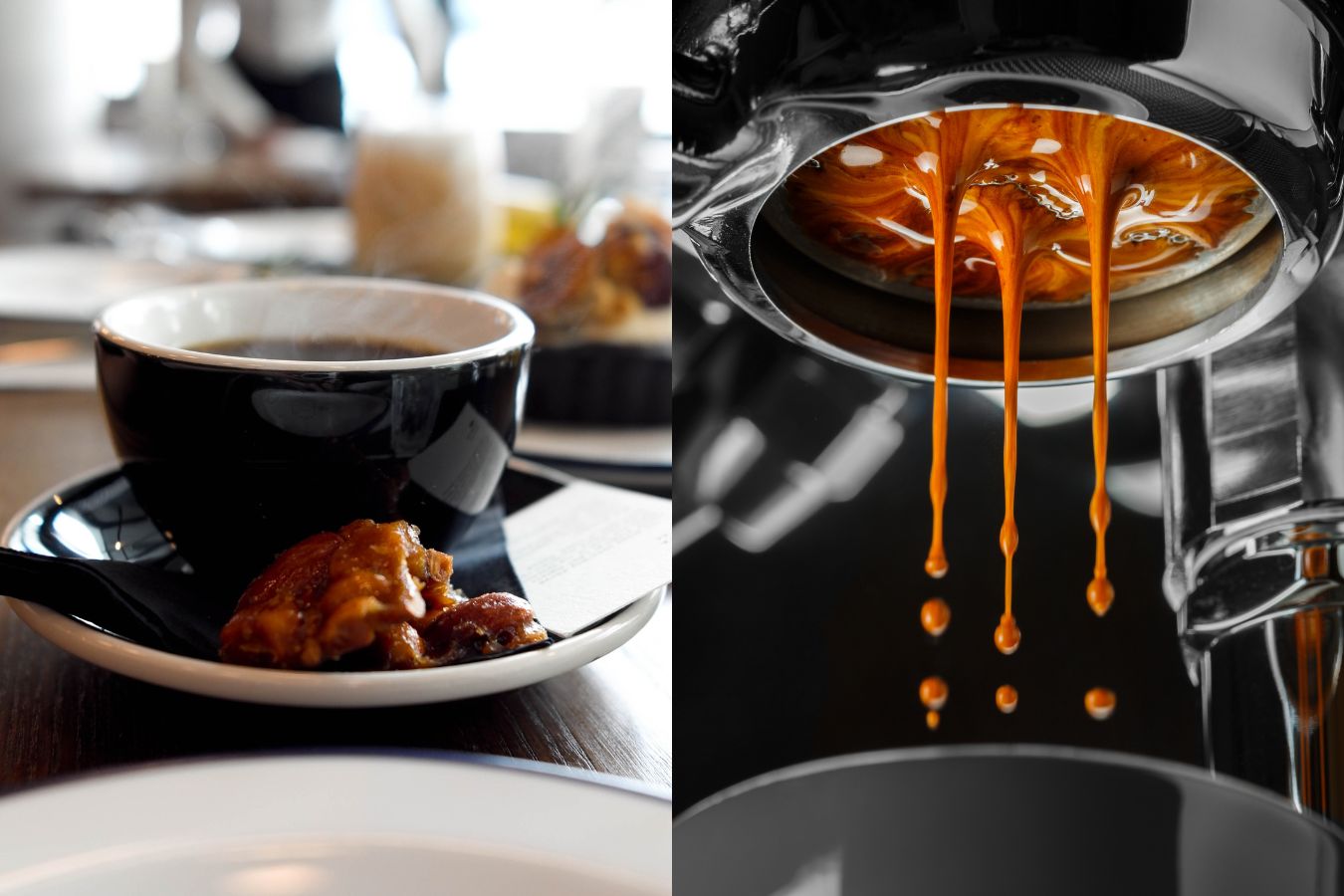The New Wave of Choosing SOE Single Origin Espresso at Home
The New Wave of Choosing SOE Single Origin Espresso at Home
Blog Article
Comprehending Coffee Beans: the Journey From Espresso to Blended Coffee Beans

The Beginnings of Coffee: A Global Viewpoint
While you may believe of coffee as a modern-day staple, its origins map back centuries, intertwining with cultures throughout the globe. The story starts in Ethiopia, where legend claims a goat herder named Kaldi uncovered the invigorating results of coffee beans after seeing his goats frolicking energetically after eating them.
As profession paths increased, coffee made its way to Europe in the 17th century, promptly acquiring appeal. Each culture included its distinct twist to coffee prep work, improving its background.
Cultivation and Harvesting of Espresso Beans
As coffee's journey progressed, the focus changed to the farming and harvesting of specific bean selections, specifically those used for coffee. You'll discover that coffee beans frequently originate from Arabica or Robusta plants, each offering distinctive flavors. The excellent expanding conditions include high altitudes and abundant, well-drained dirt, which improve the beans' high quality.
During the harvest, selecting techniques differ. In some regions, employees hand-pick ripe cherries, ensuring just the most effective fruit goes to processing. In various other areas, mechanical farmers are made use of, specifically on larger ranches. Timing is important; you intend to harvest when the cherries reach peak perfection for optimum flavor.
When gathered, the beans are planned for processing, which is essential in determining their final preference. Understanding the cultivation and collecting processes gives you insight right into what enters into your preferred coffee, enhancing your recognition for every mug.
Processing Techniques: From Cherry to Bean
Currently that you have actually found out about collecting espresso beans, allow's explore exactly how those cherries change right into the coffee beans you like. You'll see exactly how various harvesting techniques effect taste, complied with by the essential steps of fermentation and drying. We'll damage down the milling and grading process that identifies your coffee's quality.
Gathering Methods Explained
When it involves coffee, understanding harvesting strategies is essential, considering that they straight affect the taste and high quality of the beans you enjoy. There are 2 primary methods: discerning selecting and strip selecting. Discerning selecting entails hand-picking just ripe cherries, ensuring you obtain the best quality beans. This approach usually causes a richer taste profile, though it's more labor-intensive. On the other hand, strip choosing ways gathering all cherries at as soon as, regardless of perfection. While it's quicker and less expensive, this can result in a mix of flavors, influencing the final item. Eventually, the option of harvesting method can considerably affect your coffee experience, so it deserves understanding exactly how those beans made it to your mug.
Fermentation and Drying Out
After gathering, the following action in processing coffee beans play a substantial function in shaping their taste. You'll locate that fermentation is essential, as it assists damage down the mucilage bordering the beans, boosting their preference account. Relying on the technique, this procedure can last from a couple of hours to numerous days, with varying outcomes based on temperature level and humidity.
As soon as fermentation is full, drying out adheres to, which is equally crucial. You can pick from sun-drying or mechanical drying out methods. Sun-drying enables the beans to take in flavors from the atmosphere, while mechanical drying assurances consistent dampness degrees no matter weather condition. Correct drying is important to prevent mold and maintain the beans' quality, inevitably influencing your mug of coffee.
Milling and Grading Refine
As fermentation and drying out established the phase for flavor development, the milling and grading procedure warranties that only the very best coffee beans make it to your mug. This stage involves eliminating the outer layers of the coffee cherry, consisting of the parchment and husk. After milling, the beans are arranged by dimension and weight, making certain an uniform quality. You'll find that grading aids determine problems and categorize beans, which influences flavor and scent. High-grade beans receive a higher quality, leading to a richer coffee experience. When graded, the beans are prepared for packaging and delivery, preserving their special features. This careful process is vital for supplying the exceptional preference you enjoy in every sip of your favorite mixture.
Roasting Techniques: Unlocking Taste Potential
When you roast coffee beans, the method you choose can dramatically influence the flavor profile. Comprehending the relationship between time, temperature, and roasting strategies is essential to revealing the possibility of your brew. Let's check out exactly how these elements integrated to create the ideal mug.
Roasting Methods Described
While you might assume that all coffee toasting methods produce the very same outcomes, the fact is that each strategy reveals unique taste potentials in the beans. You can pick in between techniques like drum roasting, air roasting, and even traditional pan roasting. Drum toasting makes use of a turning drum to equally distribute heat, boosting caramelization and generating a well balanced taste. Air roasting, on the other hand, circulates warm air around the beans, advertising a lighter roast with obvious level of acidity. Pan toasting permits hands-on control yet needs constant focus to stay clear of burning. Each approach has its subtleties, so trying out with various strategies can help you discover the best roast that aligns with your taste preferences. Delight in the journey of locating your optimal cup!

Influence On Taste Account
Various roasting techniques not just affect the process however additionally considerably affect the flavor account of the coffee beans. When you choose a light roast, you'll experience brilliant acidity and flower notes, showcasing the bean's origin. In comparison, a medium roast balances acidity with sweet taste, often disclosing chocolatey undertones. Dark roasts, on the other hand, highlight bold, great smoky flavors, sometimes concealing the bean's distinct qualities. Each technique exposes different oils and compounds, leading to a broad array of tastes. By explore numerous toasting styles, you like this can uncover which profiles resonate with your palate. Recognizing these nuances assists you value the artistry behind your mug of coffee, boosting your general experience with every sip.
Time and Temperature Variables
To launch the full taste possibility of coffee beans, both time and temperature level throughout the roasting process play substantial roles. When roasting, you'll find that greater temperature levels can swiftly establish tastes, but if you hurry it, you could wind up with burned notes. Conversely, lower temperatures permit an extra gradual flavor advancement, showcasing the beans' special characteristics.

Timing is simply as vital; prolonging the roast also long can result in a loss of acidity and brightness, while as well brief a roast might leave the beans underdeveloped. Finding that pleasant place calls for technique and testing. By readjusting these aspects, you can expose the rich, complicated flavors concealed within each bean, creating a really impressive coffee experience.
The Art of Mixing: Crafting Special Coffee Profiles

Beginning by choosing a base coffee that offers a solid foundation. A brilliant Ethiopian bean can bring fruitiness, while an abundant Brazilian coffee adds body.
As you mix, bear in mind that each combination narrates. You're not simply making coffee; you're producing an experience. Take your time, preference regularly, and appreciate the trip of uncovering your signature mix - Single Origin Espresso.
Brewing Techniques: Exactly How Prep Work Affects Taste
Mixing coffee opens up a domain name of flavor opportunities, however how you make that mix can considerably affect your final cup. On the various other hand, a pour-over highlights the coffee's clearness and brightness, ideal for showcasing fragile notes.
Coffee, with its high pressure, creates a concentrated shot that emphasizes sweetness and crema. If you favor a lighter brew, consider a cold mixture technique; it produces a smooth, much less acidic taste.
Readjusting variables like water temperature level, grind size, and make time can change your coffee's profile. Embrace the art of developing to uncover the flavors concealed in your coffee blends.
The Future of Coffee: Sustainability and Technology
As the coffee industry advances, sustainability and advancement are becoming necessary for attending to environmental difficulties and meeting consumer needs. You'll observe that more coffee business are embracing environmentally friendly techniques, from sourcing beans fairly to carrying out lasting farming strategies. These shifts not only assist the world however likewise boost the high quality of the coffee you delight in.
You may see advancements like eco-friendly packaging and water-saving brewing techniques that lower waste. Advanced innovation, such as blockchain, is likewise becoming prominent, making sure transparency in the supply chain, which allows you to map your coffee back to its origins.
Furthermore, purchasing regional neighborhoods and sustaining farmers with fair trade efforts fosters a more lasting coffee ecosystem. As you drink your following cup, keep in mind that your options can add to a brighter future for coffee. By choosing sustainable brands, you're not simply appreciating a beverage; you're making a positive effect on the globe.
Regularly Asked Inquiries
What Is the Difference Between Arabica and Robusta Beans?
Arabica beans are smoother, sweeter, and have a higher level of acidity, while robusta beans are more powerful, much more bitter, and contain more high levels of caffeine. When brewing your coffee., you'll see these distinctions in flavor and scent.
Exactly How Does Elevation Affect Coffee Bean Taste?
Elevation impacts coffee bean flavor substantially. Higher elevations create beans with brighter acidity and complicated flavors, while lower elevations commonly generate beans that are much heavier and much less nuanced. You'll notice these differences in your cup!
What Are the Health Advantages of Alcohol Consumption Coffee?
Consuming coffee can boost your power, enhance psychological emphasis, and also enhance physical performance. It's rich in antioxidants, may decrease the danger of specific diseases, and can advertise a much healthier metabolic process when eaten in small amounts.
Can Coffee Beans Be Reused for Developing?
Yes, you can recycle coffee beans for brewing, yet the taste could be weaker. If you take pleasure in experimenting, attempt reusing them in various methods, like chilly mixtures or including in smoothie mixes for an added kick.
Exactly how Should I Store Coffee Beans for Freshness?
To keep you can try these out your coffee beans fresh, store them in a closed container in a trendy, dark location. Prevent revealing them to wetness, warmth, or light, as these elements can quickly weaken their taste and scent.
Understanding Coffee Beans: the Journey From Espresso to Blended Coffee Beans.
Currently that you have actually learned about harvesting coffee beans, allow's explore exactly how those cherries Read Full Report change into the coffee beans you like.When you roast coffee beans, the approach you select can dramatically impact the flavor profile - Single Origin Espresso.While you might think that all coffee toasting techniques produce the exact same outcomes, the fact is that each method discloses special flavor capacities in the beans.Various roasting approaches not just influence the procedure however likewise significantly impact the flavor account of the coffee beans
Report this page